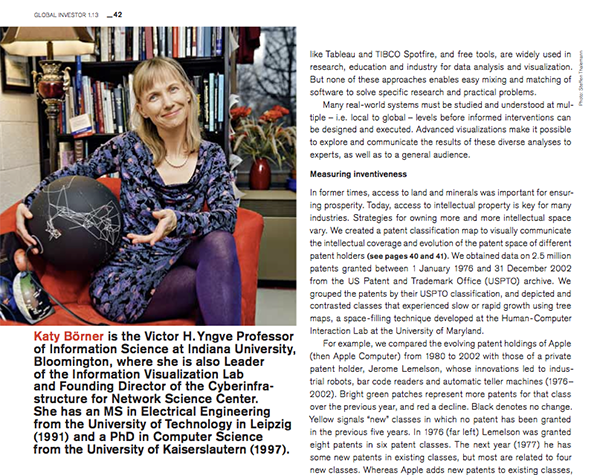Katy Börner published in Credit Suisse's Global Investor
| Global Investor

The following is an article on Big Data by Katy Börner that was featured in Global Investor Magazine. Click here to download a PDF of the original article.
Across the spectrum of human activity, decision making increasingly
means fathoming the complex systems described by Big Data. Examples
include traffic patterns, disease outbreaks and social media.
Often, the most effective way of coming to terms with this data is by
picturing or visualizing it. Throughout history, many of the best tools
for visualization have been designed by scientists keen to observe or
comprehend something for the first time. In the early 1600s, Galileo
Galilei recognized the potential of a spyglass to study the heavens,
and ground and polished his own lenses. He then used these improved
optical instruments to make discoveries like the moons of Jupiter,
providing quantitative evidence for Copernicus’s startling insight that
the earth revolves around the sun and not the other way around.
Today, scientists and industry professionals repurpose, extend and
invent new hardware and software to visually make sense of and address
local and global challenges. For example, they might combine
data on global population density, patient records and social behavior
– all large, complex data sets – to model, visualize and forecast
the spread of epidemic diseases. Or they might (and did) map how
New York City tweeted during Hurricane Sandy. Multivariate visualization
is not new. In 1786, William Playfair published the first known
time series by charting English exports and imports over 80 years. In
1861, Charles Joseph Minard famously plotted date, temperature,
direction of movement and three other variables in a poignant “narrative”
graphic of Napoleon’s failed Russian campaign. What is different
now is the sheer volume of data to be sifted through.
Plug-and-play visualization tools
Visualizing Big Data is inherently collaborative. But good data sets
are hard to obtain, and standard tools are lacking. Consequently, at
the Cyberinfrastructure for Network Science Center at Indiana University,
we have created an open-source, community-driven project
for exchanging and using data sets, algorithms, tools and computing
resources. In particular, we have developed software tool sets (called
“macroscopes") that enable non-computer scientists
to plug and play data sets and algorithms as easily as they share
images and videos using Flickr and YouTube. Our tools have been
downloaded by more than 100,000 users from over 100 countries.
Other open-source software projects, such as Google Code and
SourceForge.net, do exist. Websites like IBM’s Many Eyes enable
community data sharing and visualization. Commercial programs
like Tableau and TIBCO Spotfire, and free tools, are widely used in
research, education and industry for data analysis and visualization.
But none of these approaches enables easy mixing and matching of
software to solve specific research and practical problems.
Many real-world systems must be studied and understood at multiple
– i.e. local to global – levels before informed interventions can
be designed and executed. Advanced visualizations make it possible
to explore and communicate the results of these diverse analyses to
experts, as well as to a general audience.
Measuring inventiveness
In former times, access to land and minerals was important for ensuring
prosperity. Today, access to intellectual property is key for many
industries. Strategies for owning more and more intellectual space
vary. We created a patent classification map to visually communicate
the intellectual coverage and evolution of the patent space of different
patent holders (see pages 40 and 41). We obtained data on 2.5 million
patents granted between 1 January 1976 and 31 December 2002
from the US Patent and Trademark Office (USPTO) archive. We
grouped the patents by their USPTO classification, and depicted and
contrasted classes that experienced slow or rapid growth using tree
maps, a space-filling technique developed at the Human-Computer
Interaction Lab at the University of Maryland.
For example, we compared the evolving patent holdings of Apple
(then Apple Computer) from 1980 to 2002 with those of a private
patent holder, Jerome Lemelson, whose innovations led to industrial
robots, bar code readers and automatic teller machines (1976–
2002). Bright green patches represent more patents for that class
over the previous year, and red a decline. Black denotes no change.
Yellow signals “new” classes in which no patent has been granted
in the previous five years. In 1976 (far left) Lemelson was granted
eight patents in six patent classes. The next year (1977) he has
some new patents in existing classes, but most are related to four
new classes. Whereas Apple adds new patents to existing classes,
Lemelson follows a different strategy to claim more and more intellectual
space. This longitudinal comparison helps to reveal an assignee’s
past, current (and possibly future) intellectual limits and
patenting behavior.
Mapping the future
Data literacy will soon be as important as being able to read and write.
In January 2013, registration opened for the Information Visualization
MOOC (massive open online course) that I am teaching at Indiana
University. Students from 93 different countries
are taking theory and hands-on lessons. The course introduces
a theoretical framework that helps non-experts to assemble advanced
analysis workflows and to design different visualization layers, i.e.
base map, overlay (real-time) data, and color and size coding. The
framework can also be applied to “dissect” visualizations so they can
be interpreted and optimized. As part of the course assignments,
students work in teams on real-world client projects.
Developing the visualization tools to handle Big Data images,
videos and data sets for scholarly markets remains a work in progress.
Our current efforts focus on ways of ensuring data quality, dealing
with streaming data such as from social media, and making our tools
more modular and even easier to use. The ultimate goal of Big Data
visualizations is to understand and use our collective knowledge of
science and technology to enable anyone to explore complex technical,
social and economic issues and to make better decisions.





